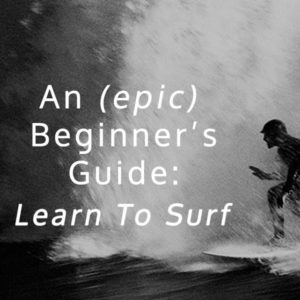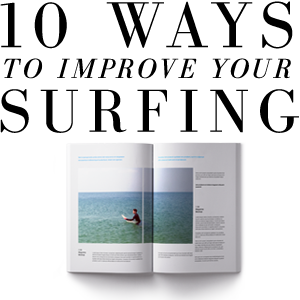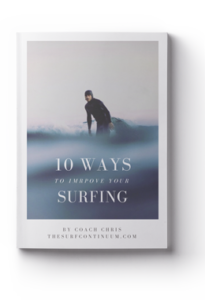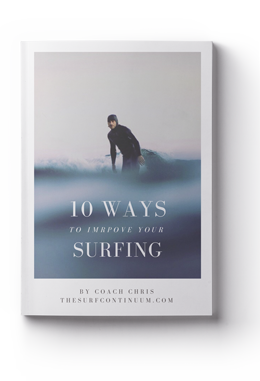Learning How to Read Waves
This is a great topic, but also the most complicated and difficult to teach with just words and pictures. Nonetheless, the goal is to spark some inspiration in you so you can start the process of teaching yourself how to read waves, and/or confirm some knowledge you already have.
But you have to realize–the only true way to learn how to read waves is to watch, study, and interact with waves for the rest of your life.
Use this guide to supplement your observations.
Before we move forward, there are two questions that must be answered and understood.
- What are waves?
- What are we trying to read?
Knowing the answers to these two questions is the beginning for understanding how to read waves and predict their behavior as they approach a surf spot.
What Are Waves?
Waves are the result of energy moving through the water.
That means, a wave is not a traveling bump of water. That bump in the water you observe approaching the beach is actually the energy (aka wave) that is traveling through the water. Kind of like a cartoon ground hog making a bump in the land above him as he scurries underground.

The ground is the not moving, but the animal under the ground is moving and you can tell by the earth he lifts up as he goes.
Just as the wind sways trees and lifts a flag, wave energy lifts water. In both cases, you cannot see the source energy, but you can see how that energy affects the things around it.
Wave Dimensions
One thing any observer can tell is that all waves are not the same. Some are powerful and carry a lot of energy, and some waves are weak with little energy.
A wave’s energy is measured with three main dimensions. When you’re learning how to read waves, it important to take these three dimensions into account, not just the height.
Similar to how volume is calculated through multiple dimensions (e.g. length x width x height). We measure ocean energy through their height, interval (time between two waves), and their direction. Knowing their direction helps us determine the angle they will approach a beach.

- h = wave height (measured in feet or meters)
- i = swell interval (measured in seconds as the time it takes two peaks of energy to pass a fixed point, like a buoy)
- d = swell direction (point on a compass from where a swell originates)
So What Are Waves Again?
They are energy.
They are all around us in different mediums like light and sound, but the ones surfers want to ride move through bodies of water.
The more you know about how and why they change shape and break, the better you can use your fundamental skills to position yourself to catch them.
Are you a master of Surfing Fundamentals? You better be if you want to take all this knowledge about waves and use it to catch more!
What Are We Trying To “Read”?
The next question we need to answer is what exactly are we trying to read in the waves?
The three things a beginner surfer should aim to understand is:
- How far out a wave will break from the beach.
- What kind of shape it will make when it breaks.
- How fast will the sections of the wave break down the line.
These three things are important because it determines first where a surfer must be in order to catch the wave best. Secondly, to anticipate how you should take-off on the wave you caught. Lastly is to know what kind of angle or approach you should take towards the shoulder so you can spend the maximum amount of your ride in the pocket.
Distance: Why Do Some Waves Break Near Shore and Others Far Out?
First you need to understand why waves break in the first place.
Waves break because they grow too tall and unstable to stand against gravity. Like a child stacking building blocks, at some point the blocks will topple.
Remember that waves are energy traveling underwater as depicted by the circles in the image below.

As the wave energy approaches the beach the water gets shallower. The energy begins to “feel” the ocean floor. Since the ocean floor is sloping up towards the beach it pushes the wave energy up above sea level (that’s the bump you see growing when you watch a wave approach the beach).
When waves grows taller and taller until they break, you are witnessing the effects of traveling wave energy being pushed upwards as the sea floor rises closer to the ocean surface, which eventually becomes the beach.
As a wave makes its final reach to the sky and begins to break is where you’ll find the reef or sandbar that gives the wave energy that last push upwards against gravity. That is the moment a wave has become too tall for its own support and breaks.
Every swell, and different surf spot the swell interacts with is different. Therefore, the time at which the waves of a given swell will break is different for every swell and every surf spot.
There’s another very important lesson here:
The more you know about the sea floor of your surf spot, the better you can position yourself in advance to catch waves. This is especially true if you surf where the shape of the sea floor hardly changes (reef breaks, point breaks).
Surfers want to paddle out far enough past the breaking point of the waves. What we are doing is positioning ourselves where the water is too deep for waves to break. However, we want to remain close to the reef where waves break so we can paddle and catch it before it breaks.
Since every wave has it’s own unique differences, they all hit the sand bar/reef a little differently. This is why waves of the same swell can break in varied distances from the beach or reef.

Therefore, a surfer’s position in the ocean cannot be stationary. We must constantly paddle around according to what we read in every next wave.
The ability to position yourself on that fine and dynamic line between where a wave breaks and doesn’t break is one of the first skills to pair with reading waves a new surfer should want to cultivate.
Since every wave in a given swell contains varying amounts of energy, that fine line between safely outside and caught in the impact zone is constantly shifting. Strong fundamentals is what aides a surfer in moving to and staying in position with this dynamic location.
Wave Shape: What Causes Waves to Break with Different Shapes and Power?
All waves eventually break in some fashion or another. We now know this happens when waves enter water that is too shallow to support their height and energy. The next bit to discover is:
What variable causes waves at one surf spot to break fast and round, while the same swell hitting another surf spot create waves that break slow and with a gently sloped face?
Waves that develop and break slowly are great for beginners. When they reach the height where they will break, they gently spill over creating a mellow kind of breaking wave. Surfers usually call a wave like this, mushy. Mushy waves are great for beginners learning how to catch their first waves. They are slow, soft, not steep, and less consequential.
Bad waves for beginners are waves that grow and break quickly. Rather than spill, the crest will pitch out through the air towards the beach creating a round, concave wave face as the lip impacts the trough. Waves that pitch and break “top-to-bottom” are fast, powerful, concave, and not good for beginners. You have a small window to pop-up, and the consequences of bad timing are much greater compared with mushy waves.
But why do some waves break fast, and some break slow?
Remember, waves break because they come into shallow water.
How quickly they break is due to the rate at which the ocean floor rises up to the beach.
A good beginner’s surf spot will typically have a long, and slow slope from beach to sea. Like a boat ramp that gradually descends deeper into the water.
On the other hand, a challenging wave approaches the beach in relatively deeper water until it suddenly enters shallow water. This abrupt change in depth causes the waves to pop up, quickly lurch, and become rapidly unstable which leads to a fast and powerful break.

Waves move faster in deeper water and slow down when they enter shallow water and feel the ocean floor.
If the wave slows down slowly, as in the case when a wave approaches a gradual and slowly inclining floor of a beginner surf spot, it will also break slowly. But if a wave traveling in deep water suddenly hits shallow water, the wave will become steep quickly, and become concave as it breaks quickly.
Knowing this can help you understand a little bit about the sea floor under your surf spot, which will help you read the waves better and make wise decisions about where and how you should surf. Both in and out of the water.
Geography & Bathymetry
Lets recap before moving forward:
- Waves are energy traveling through the ocean.
- Waves slow down, grow, and eventually break as they refract towards shallow water
- The steeper the slope of the local sea floor, the faster and more challenging the waves will be.
- And generally, the more gradual the slope of the sea floor, the more gentle the waves break.
Have you realized yet? Knowing the characteristics of the sea floor where you surf is directly related to your success in reading waves.
Now let’s try to understand how coastal variation and the irregular nature of the ocean floor contribute to how waves break.
Note: A quality surfing wave breaks down the line in sections. A poor quality wave either closes out, or breaks in sections down the line much faster than a surfer could keep pace with.
For the purposes of this post, geography is defined as the land and its arrangement of physical features. Bathymetry (can be categorized as local and offshore) is the submarine topography of the sea floor that depicts depths and shapes of underwater terrain. Similar to how a topographic map show’s heights above sea level on a map, bathymetry expresses the depth of water below the ocean surface in the same manner. Remember the steeper the slope of the local bathymetry, the faster the waves build and break.
If the coast line were always simple and straight, and the ocean floor was the same with a smooth, and consistent slope, these factors would be less important in our quest to learn how to read waves. But since the geography and bathymetry of many coastlines are varied and organic, as well as the ocean floor is, these two factors play a major role in where and how waves break.
Case Study: A Point Break
A point break is shining example of how geography and bathymetry work together to offer quality waves that break in a very predictable pattern.
Geographically, a point break is defined by a headland that sticks out into the ocean. This geographical shape is continued under water in terms of depth contours paralleling the geographic headland feature, which causes waves that approach it to refract (bend) around this feature.

In the image above, the blue lines are showing the shape and depth of the sea floor. Each line represents another foot of depth as you move away from the shoreline towards deeper water.
Key Term: Refraction. The process by which a wave changes direction due to the energy of said wave interacting with the ocean floor. As a band of wave energy approaches shallow water, the part of the wave line interacting with the shallows will slow down and refract towards the shallow water. The part of the wave in deeper water will continue moving at it’s original pace which results in the common site at point breaks of waves bending or “horseshoeing”, as surfers might say, around a headland.
The best point breaks in the world (Rincon, Malibu, Pavones, J-Bay etc.) are positioned along a coast with open exposure to long interval wave energy, and where the predominant swell direction arrives at an angle relative to the headland. This further promotes the wrapping/refraction effect that occurs when long interval energy approaches an irregularly shaped coast line.

As bands of energy approach the irregular shape of a costal headland, some parts of the wave line will enter shallow water, while other parts of the wave line stay in deeper water. When this happens it causes part of the wave line to slow down and break. Any part of the wave line that is not in shallow water will continue on without slowing or breaking until it reaches shallow enough water.
As the line of a wave continues to travel along the angle of the headland, more of the wave line will interact with shallower water. Observed from the beach, the result is a wave that breaks section by section, down the line in one direction or another following the depth contours of the surf spot.

Case Study: Beach Breaks
Beach breaks are exciting spots to score when they’re on, but can be much more fickle. Because beach breaks are generally long stretches of sandy beach and offer little in geographic variation (which would give the waves something to bend around and break in sections) we must rely on the local bathymetry of the spot to produce an ocean floor capable of producing quality waves for surfing.
The ocean floor of a beach break is usually mostly sand. This makes the bathymetry of a beach break dynamic and ever-changing capable of producing all-time waves. Of course, in just a few hours, the orientation of sand can change resulting in poor quality waves.
Unlike a headland who’s geographic shape and related bathymetry can remain unchanged for thousands of years, sand is moving constantly. When sand is moved around by waves, wind, and tide, it piles up and settles underwater creating an infinite number of bathymetric possibilities.
Sometimes the sand settles in a way that resembles an under water point break, other times the sand settles uniformly from the left of the beach to the right. This doesn’t typically create a quality wave because as the wave energy approaches, the entire line of the wave interacts with the bottom at the same time and causes a wave to close-out. Despite the fact that there may be waves, the quality of how they break can be unsuitable for surfing.
At some beach breaks, the sand is hard packed and moves around less. However, many beach breaks are made of loose sand that is constantly on the move. A surfer who’s local beach has this characteristic needs to be monitoring the sandbars daily and noting how the waves are interacting with them.
You should always keep your attention on your local spot, and determine often whether the waves are breaking along a good sand bank or not. This is another reason why beach breaks can be less crowded than point breaks. They can be challenging to understand when they’ll turn on compared with a point break. Typically, a point break is kind of an automatic score when there is swell.
At beach breaks, not so much. Forecasting when a breach break will get good is a tedious balance between lucking into a good sand orientation (the dynamic local bathymetry), the right amount of water (tide), and the right amount of swell relative to the tide.
Even when the sand is good, if there’s too much swell for the tide, or too much tide for the swell it can temporarily kill your chances of scoring good waves.
With so many varying factors (especially the ones you can’t predict like sand movement), scoring a beach break when it’s working is a glorious thing. And when it does happen you’ll generally find yourself surfing with only a few other surfers who were committed enough to be on their game and likely had been keeping their eyes on the sand for the days leading up to the good one.
If you didn’t understand it before, you should now. When a surfer says, “the sands good”, or “the bars are working” they are talking about the current state of the sand bars. When they’re good it means the local bathymetry (the sand bars) is causing the waves that break over them to peel down the line, section by section.
Contributing Factors for Successfully Reading Waves
Having covered the major aspects of why waves break, and in what manner and shape they will break, this information would be incomplete without recognizing some of the other factors that can affect waves breaking. Both wind and tide bring in some additional variables that will affect when waves break, and in what shape they will break.
Wind
Wind is described in two dimensions. Direction and intensity. The direction can be expressed via cardinal points and from where the wind originates (e.g., North, West, South East, etc.) or where the wind is going relative to the angle of the beach (e.g., onshore, side shore, offshore, etc.).
For this articles purpose, we will describe the wind in terms of where it is going relative to the beach. Each of those wind types has an affect on how a cresting wave will break. Let’s examine each wind case.
- Onshore: This kind of wind is coming from the ocean and blowing towards the shore. It generally causes waves to break sooner than they would had there been no wind, or wind from a different direction.
- Offshore: This kind of wind is coming from land and blowing towards the ocean. It generally causes the waves to break later and in shallower water than they would had there been no wind, or the wind was blowing in a different direction.
- Side-shore: This kind of wind blows parallel to the beach either left or right. Typically, this kind of wind wont affect when the wave breaks, but more so the visual of how the wave looks as it breaks.
- Side-Offshore: This kind of wind is not really blowing directly from land to ocean, but it also can’t be categorized as side shore since the wind is coming slightly from land. It can have similar affects on waves as do the offshores, perhaps less extreme. You may also see characteristics of side shore conditions on the face of the wave and in the lip (side-shore chop).
Tide
You may realize that the water level of all significant bodies of water ebbs and floods (retreats and fills). This is due to the gravitational pull of the sun and moon. As the water level rises to its peak height (high tide), slacks off, and recedes to its lowest point (low tide), not only are currents of water movement created, but the depth of water over your favorite sand bar or reef is constantly changing.
You already learned that bathymetry (the depth contours) is directly related to how and why waves break. When you observe waves breaking over a reef or sandbar over the course of the day, you should start to notice that more or less water over the local bathymetry can affect how close or far waves break from the beach. It can also affect the shape of the wave when it breaks.
A wave that is mushy and good for beginners at high tide can become a hollow, powerful wave at low tide.
Tide is a challenging topic to be able to accurately predicts the affects it will have on the waves. Its a dynamic variable that comes into play differently at every surf spot around the world, and the only way to learn it better is by paying attention to the high and low tide times and keep them in mind when you check the surf, while you surf, or while you sit on the beach and watch the waves.
Did you like this article? Check out some of our other articles like 9 Things Every Beginner Surfer Should Know, and What is a Kook?




